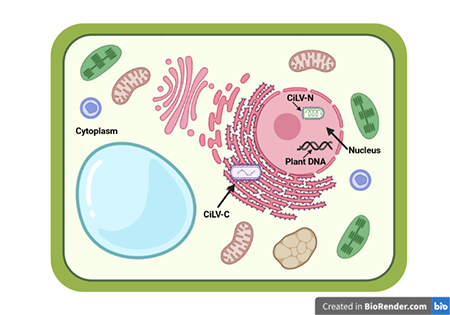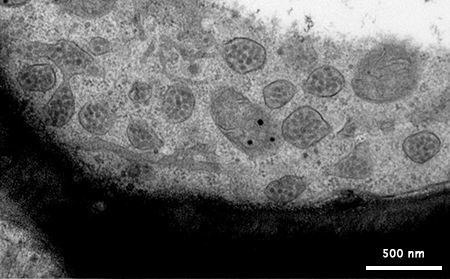History of Citrus Leprosis
Citrus leprosis is a non-systemic viral disease that is currently found in Mexico, Brazil, and other countries in South and Central America. The causal agent is the Citrus leprosis virus and the virus is transmitted by the Tenuipalpidae family of flat mites, genus Brevipalpus. These mites are found throughout Florida on many plant hosts.
There are two main types of leprosis: C-type and N-type. The names refer to where in the cell the virus is located (see image below). The virus in the C-type leprosis cytoplasm of the cell and the virus in the N-type leprosis in the nucleus. The C-type Leprosis is more aggressive than the N-type. The symptoms of each type of virus vary subtly and are best identified via the appropriate molecular test. If leprosis were to be detected, identifying the specific virus type would help regulators and researchers better understand what mites and viruses were part of an outbreak. The C-type virus is the most widespread of the viruses and has spread from southern Mexico to rest of the citrus producing regions of Mexico between 2013 and 2019.
|
Transmission electron microscopy of particles of CiLV-C inside Valencia sweet orange cell in Mexico.
|
In the 1860’s, leprosis was found in Florida and resulted in reduced citrus production. By 1926, there was a decline in the incidence of leprosis, and by the 1950’s it was reported only on the east coast in small, isolated areas. It is unclear why leprosis disappeared from Florida. It is thought that the increased use of miticides and cold winter temperatures contributed to the severe decline in mite populations, resulting in reduced inoculum and transmission. Leprosis had not been reported in Florida since 1968.
Fruit Symptoms
Sweet orange and mandarin varieties are most susceptible to leprosis, but it can also affect grapefruit and other varieties. The rind of the fruit is affected by lesions produced where flat mites feed. Interestingly, the greatest amount of virus are found in the fruit lesions. As the fruit matures, the lesions become more pronounced and can be circular or irregularly shaped. The lesions can be either single or become coalescent. The centers of the lesions may crack with high temperatures. Fruit infected with leprosis can change color early and become susceptible to rot. Premature fruit drop can occur from multiple lesions being present on the fruit, resulting in yield loss. Flowering is unaffected by leprosis.
Leaf and Stem Symptoms
Each lesion represents a feeding spot from a mite. The symptoms typically take 1-2 months to appear after inoculation (when the virus is spread to the plant by the mite). Leaf symptoms of leprosis start as yellow chlorotic spots and become brown in color. The lesions may also develop necrotic centers as they age. Leaf lesions are smooth to the touch. With severe infection, premature defoliation of the canopy can occur, which affects the health of the tree and impacts fruit production.
Stem and twig symptoms begin as chlorotic, shallow lesions that become dark brown to reddish in color. As the lesions age, they become corky and develop into scaling of the bark. The lesions can also cause girdling of the stem when they coalesce, resulting in stem and twig dieback. Tree sections and an entire tree can die if not managed.
Photo Gallery
Spread
Citrus leprosis is spread by several species of flat mites (Brevipalpus sp.). As the mite feeds on the leaf, stem, or fruit, the plant tissue is infected with the virus. The mite can transmit the virus in any active stage of its life, but the virus is not thought to be transovarial, which means it is not transmitted from the female to her offspring. For a mite to be infected with the virus, it must feed on infected plant material. Once the mite has the virus, the mite remains infectious for the remainder of its lifespan.
Regulations and Management
USDA-APHIS has developed a recovery plan for if and when leprosis enters the United States. This recovery plan can be found below in the links section. Brevipalpus mites are present in Florida, which increases the potential of a leprosis outbreak. When replanting in the field, only use clean nursery stock from registered nurseries. Monitoring of groves and early detection are essential to reduce the spread of the disease and aid in eradication efforts. Educational resources and identification tools should be utilized by grove workers, managers, and other industry professionals to increase awareness and knowledge of this disease. Controlling weeds, movement of infected plant debris, and the movement of people in the grove can reduce the risk for leprosis. In affected areas, growers should prune out and burn diseased wood to reduce the amount of inoculum present and chemical control of mites is recommended to reduce populations.
How to Report a Suspected Find
As with all exotic diseases, it is important to be vigilant for potential symptoms. If you suspect you may have leprosis, please submit a sample to the Florida Department of Agriculture and Consumer Services. For sample submission instructions, please visit https://www.fdacs.gov/Agriculture-Industry/Pests-and-Diseases/How-to-Submit-a-Sample-for-Identification
Presentations
Publications
- FDACS Pest Alert (June 2021)
- Citrus Leprosis Fruit, Leaf, and Stem Symptom Identification
- Citrus Diseases Exotic to Florida: Citrus Leprosis
- Exotic Citrus Diseases Brochure
- Enfermedades Exóticas De Los Citricos
- Citrus Leprosis Research Update
- Review of Exotic Citrus Diseases
Links
- Recovery Plan for Citrus Leprosis, USDA
- Leprosis Fact Page, ID Tools
- Citrus Leprosis Centennial of an Unusual Mite-Virus Pathosystem
Contacts
For questions, please email crec-web@ifas.ufl.edu
| UF/IFAS Citrus REC (863.956.1151) |
||
| Amit Levy, Ph.D. | Plant Virologist | amitlevy@ufl.edu |
| Lauren Diepenbrock, Ph.D. | Entomologist | ldiepenbrock@ufl.edu |
| Jamie Burrow, M.Agr. | Extension Program Coordinator | jdyates@ufl.edu |
| Megan Dewdney, Ph.D. | Plant Pathologist | mmdewdney@ufl.edu |
| Ron Brlansky, Ph.D. | Professor Emeritus, Plant Pathology | rhby@ufl.edu |
| Lukasz Stelinski, Ph.D. | Entomologist | stelinski@ufl.edu |
UF/IFAS Southwest Florida REC (239.658.3400) |
||
| Ozgur Batuman, Ph.D. | Plant Pathologist | obatuman@ufl.edu |
| Jawwad Qureshi, Ph.D. | Entomologist | jawwadq@ufl.edu |
Florida Multi-County Citrus Extension Agents |
||


